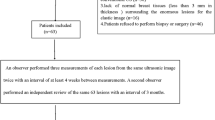Abstract
Purpose
To evaluate tissue stiffness values around breast lesions and stiff rim sign for the differentiation of benign and malignant lesions.
Methods
A total of 192 patients (mean age, 44.6 ± 13.6 years) with 199 breast lesions were included in this retrospective study. All lesions were pathologically proven by US-guided core needle biopsy (CNB), Mammotome biopsy, or surgery. We first observed the presence or absence of a stiff rim sign, which was defined as a red or orange halo around the breast lesion. The shell around the breast lesion on SWE was then automatically drawn by machine, with a width of 1 mm, 2 mm, and 3 mm. The elasticity moduli of the lesion and surrounding tissue were recorded, including maximum elasticity (Emax), mean elasticity (Emean), minimum elasticity (Emin), and elasticity ratio (shell/lesion ratio). The optimal thresholds of elasticity moduli were calculated according to the receiver operating characteristic (ROC) curve.
Results
There were 75 malignant lesions and 124 benign ones. The average Emax and Emean of lesions and shell were significantly higher in the malignant group than in the benign group (P < 0.05). The optimal cut-off value of Emax for diagnosing malignant lesions was 101.7 kPa, with a sensitivity of 66.3% and specificity of 87.9%. The optimal cut-off value of Emean was 29.1 kPa, with a sensitivity of 65.3% and specificity of 79.8%. The stiff rim sign had the highest diagnostic performance for malignancy as compared with other elastic parameters, with an accuracy of 88.4%. However, measuring peritumoral tissue stiffness can achieve relatively high sensitivity, whereas specificity was not improved significantly.
Conclusions
The stiffness of tissue surrounding breast malignancies was significantly higher than the surrounding benign lesions. Stiff rim sign has the potential to improve the diagnostic performance of breast lesions.





Similar content being viewed by others
References
Barr RG, Nakashima K, Amy D, et al. WFUMB guidelines and recommendations for clinical use of ultrasound elastography: part 2: breast. Ultrasound Med Biol. 2015;41:1148–60.
Youk JH, Son EJ, Gweon HM, et al. Comparison of strain and shear wave elastography for the differentiation of benign from malignant breast lesions, combined with B-mode ultrasonography: qualitative and quantitative assessments. Ultrasound Med Biol. 2014;40:2336–44.
Sigrist RMS, Liau J, Kaffas AE, et al. Ultrasound elastography: review of techniques and clinical applications. Theranostics. 2017;7:1303–29.
Liu B, Zheng Y, Huang G, et al. Breast lesions: quantitative diagnosis using ultrasound shear wave elastography—a systematic review and meta-analysis. Ultrasound Med Biol. 2016;42:835–47.
Hari S, Paul SB, Vidyasagar R, et al. Breast mass characterization using shear wave elastography and ultrasound. Diagn Interv Imaging. 2018;99:699–707.
Song EJ, Sohn YM, Seo M. Tumor stiffness measured by quantitative and qualitative shear wave elastography of breast cancer. Br J Radiol. 2018;91:20170830.
Zhou J, Zhan W, Dong Y, et al. Stiffness of the surrounding tissue of breast lesions evaluated by ultrasound elastography. Eur Radiol. 2014;24:1659–67.
Park HS, Shin HJ, Shin KC, et al. Comparison of peritumoral stromal tissue stiffness obtained by shear wave elastography between benign and malignant breast lesions. Acta Radiol. 2018;59:1168–75.
Evans A, Whelehan P, Thomson K, et al. Invasive breast cancer: relationship between shear-wave elastographic findings and histologic prognostic factors. Radiology. 2012;263:673–7.
American College of Radiology. Breast imaging reporting and data system (BI-RADS) Mammography. 5th ed. Reston: American College of Radiology; 2013.
Luo J, Cao Y, Nian W, et al. Benefit of Shear-wave Elastography in the differential diagnosis of breast lesion: a diagnostic meta-analysis. Med Ultrason. 2018;1:43–9.
Li XL, Xu HX, Bo XW, et al. Value of virtual touch tissue imaging quantification for evaluation of ultrasound breast imaging-reporting and data system category 4 lesions. Ultrasound Med Biol. 2016;42:2050–7.
Liu Y, Huang Y, Han J, et al. Association between shear wave elastography of virtual touch tissue imaging quantification parameters and the Ki-67 proliferation status in luminal-type breast cancer. J Ultrasound Med. 2019;38:73–80.
Kong WT, Zhou WJ, Wang Y, et al. The value of virtual touch tissue imaging quantification in the differential diagnosis between benign and malignant breast lesions. J Med Ultrason. 2001;2019(46):459–66.
Xiao Y, Yu Y, Niu L, et al. Quantitative evaluation of peripheral tissue elasticity for ultrasound-detected breast lesions. Clin Radiol. 2016;71:896–904.
Wang ZL, Sun L, Li Y, et al. Relationship between elasticity and collagen fiber content in breast disease: a preliminary report. Ultrasonics. 2015;57:44–9.
Evans A, Whelehan P, Thomson K, et al. Quantitative shear wave ultrasound elastography: initial experience in solid breast masses. Breast Cancer Res. 2010;12:R104.
Kapetas P, Pinker-Domenig K, Woitek R, et al. Clinical application of acoustic radiation force impulse imaging with virtual touch IQ in breast ultrasound: diagnostic performance and reproducibility of a new technique. Acta Radiol. 2017;58:140–7.
Vinnicombe SJ, Whelehan P, Thomson K, et al. What are the characteristics of breast cancers misclassified as benign by quantitative ultrasound shear wave elastography? Eur Radiol. 2014;24:921–6.
Chen YP, Han T, Wu R, et al. Comparison of virtual touch tissue quantification and virtual touch tissue imaging quantification for diagnosis of solid breast tumors of different sizes. Clin Hemorheol Microcirc. 2016;64:235–44.
Funding
This study was funded by the Nanjing Medical Science and Technique Development Foundation (QRX17011).
Author information
Authors and Affiliations
Corresponding author
Ethics declarations
Conflict of interest
None.
Ethical statement
All procedures followed were in accordance with the ethical standards of the responsible committee on human experimentation (institutional and national) and with the Helsinki Declaration of 1964 and later versions. Informed consent was obtained from all patients for being included in the study.
Additional information
Publisher's Note
Springer Nature remains neutral with regard to jurisdictional claims in published maps and institutional affiliations.
About this article
Cite this article
Kong, Wt., Wang, Y., Zhou, Wj. et al. Can measuring perilesional tissue stiffness and stiff rim sign improve the diagnostic performance between benign and malignant breast lesions?. J Med Ultrasonics 48, 53–61 (2021). https://doi.org/10.1007/s10396-020-01064-0
Received:
Accepted:
Published:
Issue Date:
DOI: https://doi.org/10.1007/s10396-020-01064-0




